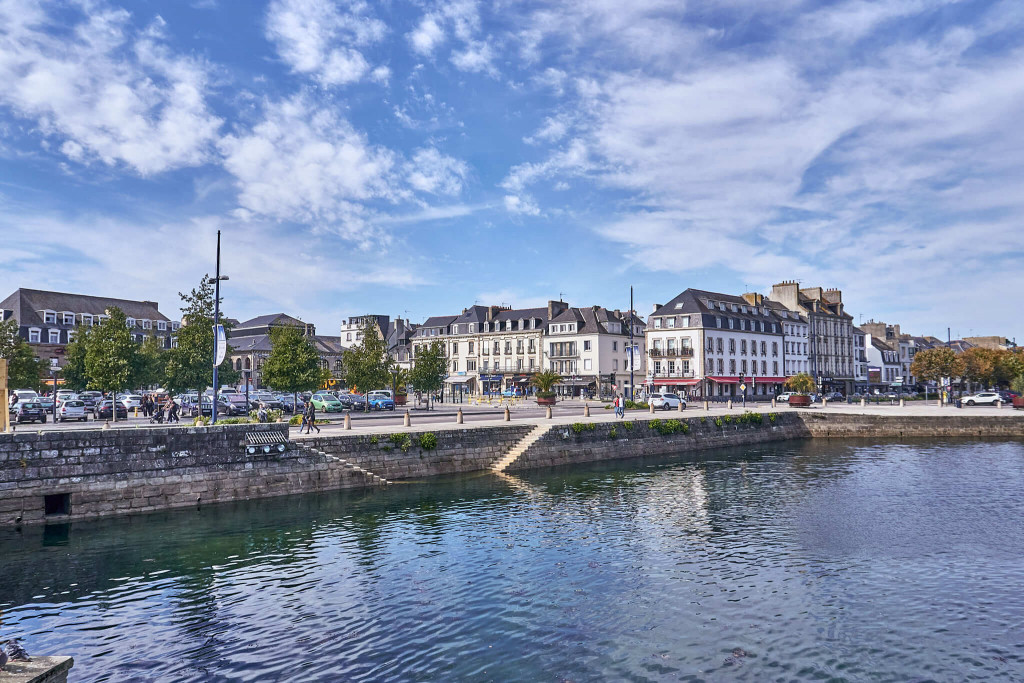The medieval stronghold of Ville Close forms a protective embrace around Concarneau, stood on a lengthy island at the heart of Concarneau harbour. Comprising only a handful of slender lanes, this walled town is just a stone’s throw away from the city and port.
Dating back to the 15th century, Ville Close has been the focal point of Concarneau throughout the subsequent centuries. Today, spanning an impressive 350 metres by 100 metres, Ville Close ranks among the top destinations in Brittany, drawing considerable crowds, especially during the bustling summer months. Fortunately, we had the pleasure of exploring this historic haven in autumn during our fortnight-long road trip through Brittany. The atmosphere was serene, with only a scattering of locals ambling about, making our visit truly special.


View from the entrance of Ville Close Old Fortified Island
Just a few minutes of walking from the shore in the harbour, a drawbridge serves as the link between the mainland and Ville Close Old Fortified Island. However, before venturing across the drawbridge, I seized the opportunity from the harbourside to capture some splendid shots of the rocky island and the cupola-clock tower overlooking the Concarneau coastline.
Lost in our excitement to explore the island, we didn’t realize I was standing next to an anchor. The anchor, paired with the clock tower, created an ideal setting for a vertical photo. As we left, we discovered this viewpoint, the most intriguing part of Ville Close, and departed feeling satisfied.
Walking on the walls of the Ville Close
Passing directly behind the drawbridge and ascending a few steps, we found ourselves atop the medieval walls. From the two towers flanking the drawbridge, I enjoyed fabulous views of the fishing port and Concarneau bay. It appeared that autumn served as the off-season, as we were the sole visitors strolling the walls that day. However, come summer, when more tourists flock in, finding space could prove a bit challenging.
The island’s eastern side, constituting about a third of its expanse, transforms into a small hilly park. A passenger ferry operates from here, shuttling across the inlet to the opposite quay at Place Duquesne. Old walls feature stairs at various points, allowing easy descent to ground level.


Picturesque streets and squares
The bustling Rue Vauban, the main street, extends from the primary entrance gate, traversing the island and linking up with the charming square, Place Saint-Guénolé. Along this route, stone houses have been transformed into attractive establishments, housing an array of shops, galleries, and restaurants. Many of these shops offer Breton souvenirs and local delicacies.
The autumn weather in Brittany proved chillier than anticipated. Considering the impending colder climate on the northern coast where we were headed in the second week, I decided to secure a jacket for myself. Thus, I ventured into a clothing store, hoping to find a windproof or waterproof jacket. To my surprise, the shop mainly featured the classic waxed Breton waterproof coat for fishermen—a style that caters to the whole family and varies mainly in colour. This distinctive style seemed prevalent not only in Concarneau but also in other cities and even small towns like the quaint fishing village of Paimpol.
Most restaurants open around lunchtime. Within half an hour, most restaurants were getting crowded. After a quick examination of menus from several restaurants, we went into L’Ecume de la Ville Close at the Saint-Guénolé square. I also ordered a pork dish cooked in cider, a typical Breton dish. The food had a strong flavour and boosted my appetite.
Most restaurants start serving around lunchtime, and within half an hour, they begin to fill up. After perusing menus from several establishments, we settled on L’Ecume de la Ville Close at Saint-Guénolé square. My choice for the meal was a pork dish cooked in cider, a typical Breton specialty. The food boasted a robust flavour, further whetting my appetite.


Visiting the Fishing Museum
Just a few metres from the main gate lies the fish museum, Musée de la Pêche. Since 1850, Concarneau has been home to numerous canneries. Around a hundred sardine and tuna fishing boats, along with about thirty factories, played a vital role in sustaining the local economy. The museum presents interesting insights into the world of commercial fishing and its evolution over the years.


Travel tips for Ville Close, the Fortified Island of Concarneau
In the harbour areas, you’ll find several spacious parking lots, such as Quai d’Aiguillon Parking and Place Du 8 Mai 1945 Parking. They’re conveniently located near the entrance of Ville Close.
For those arriving from the south by car, the nearest parking facility is situated near the quay at Place Duquesne. From there, you can hop on the ferries via Bac du Passage to reach the island, with a cost of about 1 Euro per ride.
The ideal way to experience the island is by exploring freely. If you have only a few hours in Concarneau, dedicating that time to the island is well worthwhile.
For those planning an extended stay, you’ll find hotels near Ville Close. Here are my top two recommendations:




I am trying to plan a hiking trip for 6 people through Brittany: Concarneau- Pont Aven and the Pink Granite Coast. Can you recommend a tour company that can make arrangements for transfers and taking baggage between towns?
Hi Manny,
I usually book tours from “GetYourGuide”. Perhaps you could explore tours in Brittany by clicking the widgets in the sidebar of my blog post.
I hadn’t thought about visiting this part of France before but this blog post and your beautiful pictures really make me want to book a trip.
Dear Nicola,
Yes, it is not as popular as the southern France. However, this whole area, the Brittany, is a heaven for travellers and photographers. And, the Breton culture is also unique in France.
Best regards,
Mijia